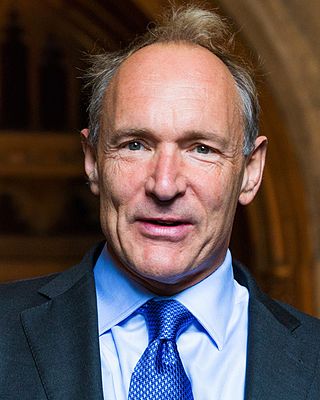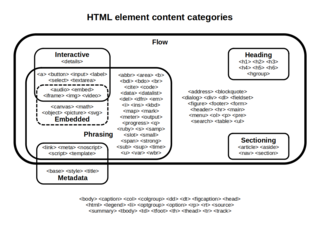Related Research Articles

The HyperText Markup Language or HTML is the standard markup language for documents designed to be displayed in a web browser. It is often assisted by technologies such as Cascading Style Sheets (CSS) and scripting languages such as JavaScript.
The Semantic Web, sometimes known as Web 3.0, is an extension of the World Wide Web through standards set by the World Wide Web Consortium (W3C). The goal of the Semantic Web is to make Internet data machine-readable.

Sir Timothy John Berners-Lee,, also known as TimBL, is an English computer scientist best known as the inventor of the World Wide Web. He is a professorial research fellow at the University of Oxford and a professor emeritus at the Massachusetts Institute of Technology (MIT). Berners-Lee proposed an information management system on 12 March 1989, then implemented the first successful communication between a Hypertext Transfer Protocol (HTTP) client and server via the Internet in mid-November.

The World Wide Web (WWW), commonly known as the Web, is an information system enabling documents and other web resources to be accessed over the Internet according to specific rules, the Hypertext Transfer Protocol (HTTP).
The World Wide Web Consortium (W3C) is the main international standards organization for the World Wide Web. Founded in 1994 and led by Tim Berners-Lee, the consortium is made up of member organizations that maintain full-time staff working together in the development of standards for the World Wide Web. As of 5 March 2023, W3C had 462 members. W3C also engages in education and outreach, develops software and serves as an open forum for discussion about the Web.
The DARPA Agent Markup Language (DAML) was the name of a US funding program at the US Defense Advanced Research Projects Agency (DARPA) started in 1999 by then-Program Manager James Hendler, and later run by Murray Burke, Mark Greaves and Michael Pagels. The program focused on the creation of machine-readable representations for the Web.

ViolaWWW is a discontinued browser, the first to support scripting and stylesheets for the World Wide Web (WWW). It was first released in 1991/1992 for Unix and acted as the recommended browser at CERN, where the WWW was invented, but eventually lost its position as most frequently used browser to Mosaic.
Web standards are the formal, non-proprietary standards and other technical specifications that define and describe aspects of the World Wide Web. In recent years, the term has been more frequently associated with the trend of endorsing a set of standardized best practices for building web sites, and a philosophy of web design and development that includes those methods.

Robert Cailliau is a Belgian informatics engineer, computer scientist and author who proposed the first (pre-www) hypertext system for CERN in 1987 and collaborated with Tim Berners-Lee on the World Wide Web from before it got its name. He designed the historical logo of the WWW, organized the first International World Wide Web Conference at CERN in 1994 and helped transfer Web development from CERN to the global Web consortium in 1995. Together with Dr. James Gillies, Cailliau wrote How the Web Was Born, the first book-length account of the origins of the World Wide Web.

The Line Mode Browser is the second web browser ever created. The browser was the first demonstrated to be portable to several different operating systems. Operated from a simple command-line interface, it could be widely used on many computers and computer terminals throughout the Internet. The browser was developed starting in 1990, and then supported by the World Wide Web Consortium (W3C) as an example and test application for the libwww library.

Libwww is an early World Wide Web software library providing core functions for web browsers, implementing HTML, HTTP, and other technologies. Tim Berners-Lee, at the European Organization for Nuclear Research (CERN), released libwww in late 1992, comprising reusable code from the first browsers.

The World Wide Web is a global information medium which users can access via computers connected to the Internet. The term is often mistakenly used as a synonym for the Internet, but the Web is a service that operates over the Internet, just as email and Usenet do. The history of the Internet and the history of hypertext date back significantly farther than that of the World Wide Web.
RDFa or Resource Description Framework in Attributes is a W3C Recommendation that adds a set of attribute-level extensions to HTML, XHTML and various XML-based document types for embedding rich metadata within Web documents. The Resource Description Framework (RDF) data-model mapping enables its use for embedding RDF subject-predicate-object expressions within XHTML documents. It also enables the extraction of RDF model triples by compliant user agents.
In computing, Terse RDF Triple Language (Turtle) is a syntax and file format for expressing data in the Resource Description Framework (RDF) data model. Turtle syntax is similar to that of SPARQL, an RDF query language. It is a common data format for storing RDF data, along with N-Triples, JSON-LD and RDF/XML.

Erwise is a discontinued pioneering web browser, and the first available with a graphical user interface.

Semantic HTML is the use of HTML markup to reinforce the semantics, or meaning, of the information in web pages and web applications rather than merely to define its presentation or look. Semantic HTML is processed by traditional web browsers as well as by many other user agents. CSS is used to suggest its presentation to human users.

CERN httpd is an early, now discontinued, web server (HTTP) daemon originally developed at CERN from 1990 onwards by Tim Berners-Lee, Ari Luotonen and Henrik Frystyk Nielsen. Implemented in C, it was the first web server software.

Dave Raggett is an English computer specialist who has played a major role in implementing the World Wide Web since 1992. He has been a W3C Fellow at the World Wide Web Consortium since 1995 and worked on many of the key web protocols, including HTTP, HTML, XHTML, MathML, XForms, and VoiceXML. Raggett also wrote HTML Tidy and is currently pioneering W3C's work on the Web of Things. He lives in the west of England.
SGMLguid, also known as "CERN SGML", "Waterloo based SGML", and "Waterloo SGML", was an early SGML application developed and used at CERN between 1986 and 1990. It served as a model of the earliest HTML specifications.
A Uniform Resource Locator (URL), colloquially termed a web address, is a reference to a web resource that specifies its location on a computer network and a mechanism for retrieving it. A URL is a specific type of Uniform Resource Identifier (URI), although many people use the two terms interchangeably. URLs occur most commonly to reference web pages (HTTP/HTTPS) but are also used for file transfer (FTP), email (mailto), database access (JDBC), and many other applications.
References
- ↑ Connolly, Dan (2000-09-07). "Kansas City, '67-'86". Dan and Mary, since 1993. Retrieved 2018-03-31.
- ↑ Connolly, Dan (1999-01-24). "Austin: '86-'90". Dan and Mary, since 1993. Retrieved 2018-03-31.
- ↑ Gillies, James; Cailliau, Robert (2000). How the Web was Born: The Story of the World Wide Web. Oxford: Oxford University Press. p. 211. ISBN 978-0-19-286207-5.
- ↑ Berners-Lee, Tim (1999). Weaving the Web. New York: Harper Collins. p. 110.
- ↑ Berners-Lee, Tim; Connolly, Daniel (June 1993). "Hypertext Markup Language (HTML)". World Wide Web Consortium. Retrieved 18 September 2010.
- ↑ Berners-Lee, Tim; Connolly, Dan (1995-09-22). "Hypertext Markup Language - 2.0: Document Structure". W3.org. Retrieved 2018-03-31.
- ↑ "The Top 25 Unsung Heroes Of The Net". Interactive Week. 1997-12-08. Archived from the original on 1999-01-16. Retrieved 2017-09-03.
{{cite news}}: CS1 maint: bot: original URL status unknown (link) - 1 2 Gillies, James; Cailliau, Robert (2000). How the Web was Born: The Story of the World Wide Web. Oxford: Oxford University Press. p. 220. ISBN 978-0-19-286207-5.
- ↑ Messmer, Ellen (1996-05-13). "New HTML gets official stamp". Network World . p. 10.
- ↑ Garfinkel, Simson L. (December 1998). "The Web's unelected government". Technology Review. 101 (6): 38–46. ISSN 1099-274X.
- ↑ "Thanks for a great 15 years at W3C | W3C Blog".
- ↑ "Our Story".